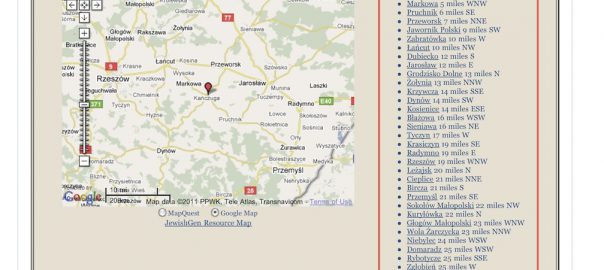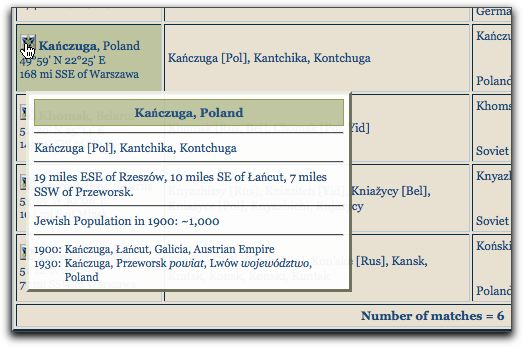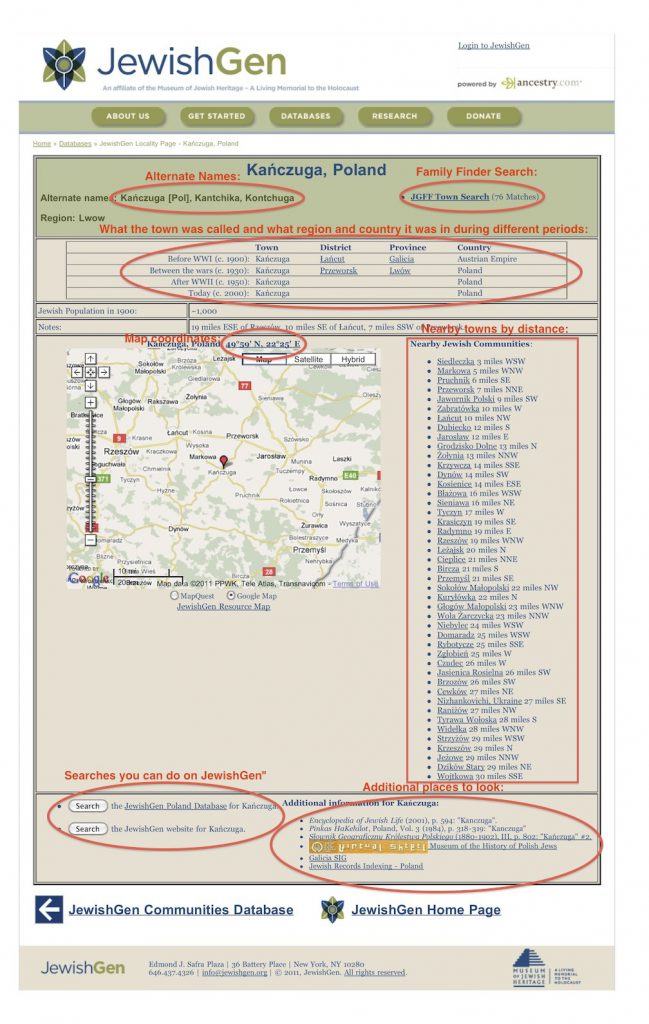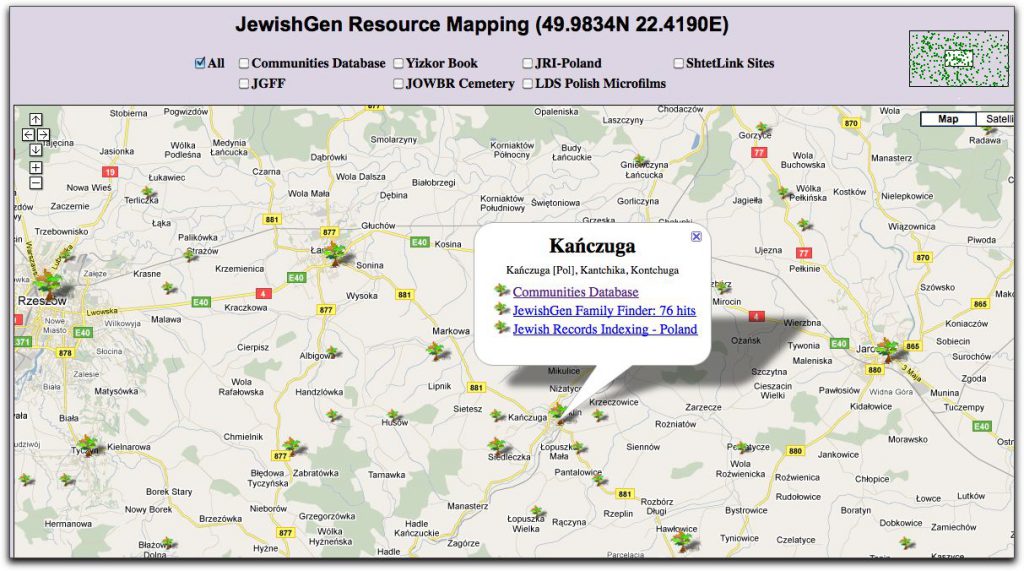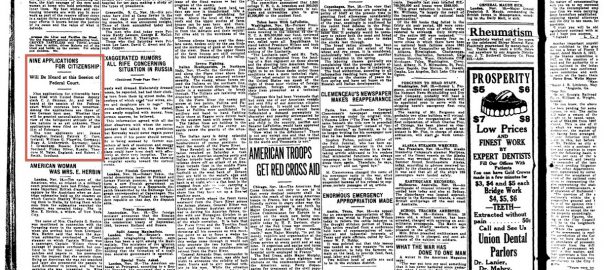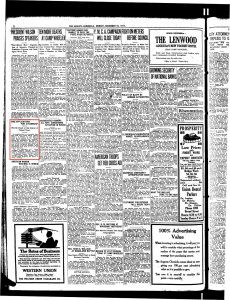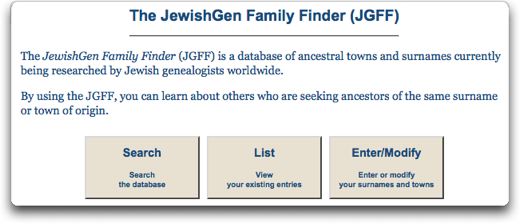[Update: This article was written in 2011, and I launched the B&F Compendium of Jewish Genealogy in 2016. If you’re researching specifically Polish shtetls, definitely check out the Polish Cities list in the compendium with more than 25,000 resources for over 1400 towns in what is now Poland (this includes towns that were in Germany before WWII and are now part of Poland).]
One of the first steps to doing genealogy research is to find the town that each person in your tree was born. For most Jewish researchers, this means tracking back to towns that may no longer exist or have not had any Jewish population for generations. Certainly the Holocaust was the cause of many of these disruptions.
A Jewish ancestral town is sometimes generically referred to as a shtetl, which in Yiddish simply means town. Shtetl is sometimes used more specifically to mean small towns in Europe with large Jewish populations. Finding your ancestral town is a different topic (or rather there are many topics related to finding one’s ancestral town), and an important one, but for the purposes of this article I will assume you already know the name of the town from which your family originated.
So you’ve found the name of the town, now what? I think the first step in doing research on the town your family came from is to find out where the town is, and what it is/was near. This might seem simple, but many of the towns Jews lived in in the past had the borders switch around them amid the wars and dealings of the empires (Russian, Austro-Hungarian and Prussian/German) that ruled them.
There are several resources that can help you find out more about your town. Two important databases on JewishGen are the Communities Database and ShtetlSeeker. These two databases are not the same, and I’ll explain the differences.
JewishGen Communities Database
The Communities Database contains information on known Jewish communities across the globe. If your town is in the database, there is a page that contains a lot of basic information on the town, as well as links to other data on the town. The resultant page is largely generated automatically. It will show you which country and region the town existed in during different time periods, as well as which towns are nearby. Knowing which towns were nearby is very important, because while you might only search your town, your relatives might have moved to the town nearby and there might be records in that town for your family that you could miss. It’s always worth looking into the nearby towns, searching the JGFF and searching for records in the nearby towns, as you are likely to find you family didn’t all live in one town.
The Communities Database does not let you search using an exact match, so it will show you results on all similarly sounding towns. If you’re searching for the first time and you don’t actually know the modern spelling of the town’s name, this can be very useful. If you know the exact current spelling of the name, then you’ll just need to scroll through the results until you find the correct name.
For example, if you were to search for ‘Kanczuga’ you would get results like the following:
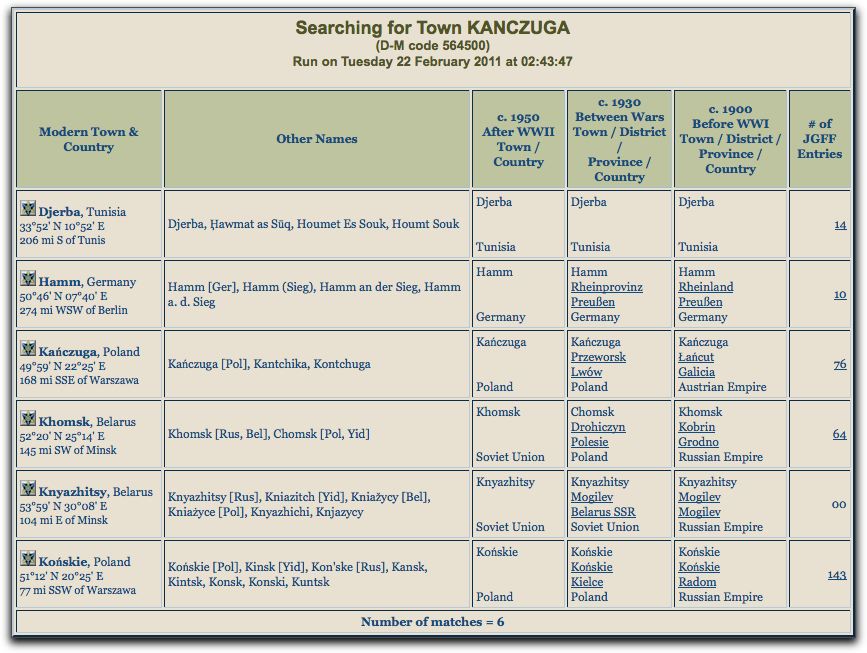
There are six results, from several countries. If I had specified Poland as the current country then there would only have been two results. Of course, you may not know which country the town is in currently, so if you are not sure then do a broader search to see all the possibilities. Only one result has the exactly spelling I searched for, which if you know the spelling means it’s easy to figure out which one is correct. Also note the other information shown in the results. It gives you the district the town was in during different periods and the number of listings in the JewishGen Family Finder (JGFF) database.
If you move your mouse over each town name, you’ll see a pop-up box giving you basic information on the town:
This can be useful if you’re not sure which town is the correct one. When you click on a town name, it will take you to a page summarizing information on that town:
If you click on the image above it will load it full size and you can see my annotations showing what to look for on the page. The key things you should notice are the alternate names for the town (useful when searching for records in databases that don’t know alternate names – like on Ancestry.com), the country the town was in during different periods (so that while you know the town is now in Poland, you now know for example to look for ‘Austria’ as a country in records because it was in the Austrian Empire), a direct link to the JGFF search, a list of nearby towns ordered by distance, and a list of other resources. Some of these pages will also link to the town’s ShtetLink page if one exists, although for some reason this Community page does not. ShtetlLinks is discussed below.
JewishGen ShtetlSeeker (Update: as of Aug 2011 this is the JewishGen Gazetteer)
The ShtetlSeeker is a bigger database that contains information on towns everywhere, even if there is no known Jewish community that existed there. It also contains geographical names, such as the names of mountains and streams. Whereas an open search above for ‘Kanczuga’ returned 6 results, an open search on ShtetlSeeker returns 303 results including Kamchikha, a section of a town, Konchuga, a town, and Kunzhuga, a stream. If the place in the list is also in the Communities Database, it will have a small flower icon next to the name of the place, and you can preview the town info with a mouse-over and click on it for more information like in the Communities Database search itself. In this case only four results have the icon next to them. Why aren’t there the same six results from the Community Database before? I have no idea.
The information in the search results is also a bit different in ShtetlSeeker. For example, this is a portion of the Kanczuga results:
If you take a look (you can click on the image to enlarge it) you can see the flower icon next to Kanczuga, indicating that it is in the Communities Database.
After the name is a column defining the name as a ‘populated place’, or as a stream, mountain, etc.
Next is a column showing the map coordinates for the location. This is actually a link that will take you to a Resource Map for that location. The Resource Map is a very useful map that shows you what resources (such as records in JRI-Poland, names in JGFF, etc.) exist on the JewishGen site for everyone in the immediate area. This is very useful, even more so if your town is not in the Communities Database, as you will be able to see what towns with known Jewish communities existed nearby, and you can then see what resources exist for those communities.
In the map above, I’ve selected Kanczuga and it has popped up a bubble showing what resources exist for Kanczuga. If I had selected any of the other little tree icons around the map, it would show me similar information for those. If you look along the top of the image, you can see that you can select what type of resources you want to see on the map, although the default is to show everything.
Going back to the search results page, the next column has links to various mapping web sites, showing you the location on each site. The mapping sites include Expedia, Mapquest, Microsoft Bing Maps and Google Maps.
Next the search results who you the current country the town is in, it’s distance from a reference point (usually a large nearby city) and a bullseye button that will take you to a new set of search results that show all towns within a 10 mile radius of the town on whose line you press the button.
JewishGen ShtetLinks (Update: As of Aug 2011 this is now KehilaLinks)
ShtetLinks is a large collections of town-specific web pages developed by real researchers who know about the town. You can think of them as the hand-made version of the Communities Database. Depending on who worked on the ShtetLink page for your town, it might be a simple one-page site with a few links, or it could be a full-blown web site with multiple sections, photo albums, historical documents, etc. It all depends on how much time and effort were put into the site by the volunteers who put together the pages. Sometimes a page was developed by someone who is no longer involved, and it hasn’t been updated in years. In these cases sometimes the administrator of ShtetLinks will post that pages need new administrators to the JewishGen e-mail list.
If you town does not have a site as part of ShtetLinks, you can of course volunteer to create one yourself. This is a great way to give back to the genealogy community.
Virtual Shtetl
JewishGen is not the only organized source for information on Jewish communities. Another site is the Virtual Shtetl, a project of the Museum of the History of Polish Jews, which is currently under construction and planning to open in 2012 in Warsaw. The site contains basic information on over 900 towns, but is meant to be a collaborative effort to collect information on the towns. Users can upload documents on the towns to share with others, and they can ‘like’ a town, similar to how someone ‘likes’ a page on Facebook. Users with interest in the same town can communicate anonymously through the site.
As the site is intended to be used both by Polish people, as well as their descendants, it is available in several languages. Some content is not yet translated into all languages, so you might find a town’s information only in Polish. Information on towns can include history, synagogue info, cemetery data, places where people were killed in the Holocaust, legends, stories, memories of the town, as well as contemporary information such as transportation, hotels and restaurants.
The Virtual Shtetl is a work in progress, and most of the resources are not yet in English, but by the very nature of its location in Poland and the attempt of the hosting museum to attract many local Poles to the site, it has a lot of potential to be a unique resource on towns in Poland.
Other Sites
There are many many other sites online with information on specific towns, regions and countries. Many people have created their own web sites with information on their ancestral town, or started a Yahoo Group or Rootsweb mailing list for their town. Try searching for your town name and seeing what you find. Use the alternate names from the Community Database in your searches as well, as you never know which version of the name a person used online. Keep in mind that some of these groups and mailing lists may not have a lot of people, or a lots of message traffic in them. That could be good or bad depending on your perspective. As long as there are knowledgeable people on the lists, it doesn’t really matter how often people post to it, as long as there is someone who knows how to answer questions posed on the list.
Figure out which region your town was in, as there may be regional sites as well. Kanczuga, the town I used as an example above was in the Galicia region of the Austro-Hungarian Empire before WWI. That means the Gesher Galicia organization is a great place to look for information. Gesher Galicia even has a sub-group for the specific region of Galicia Kanczuga was in, the Kolbuszowa Region, which has its own web site. On Rootsweb there is an Austro-Hungarian-Jewish list, and on JewishGen there is a Gesher Galicia mailing list.
Google, beyond the straight web site search which you should do has two other sites that you can use to research your town. Google Books contains the scanned contents of millions of books from all over the world, and will show you which books mention your town. If the book is out of copyright, you may even be able to download the whole book. If it’s still in copyright, you still might be able to search inside the book and find out information, depending on what the publisher allowed Google to do. Google News Archive is a site for searching news sites including some that you will need to pay for if you want to read the whole articles. Again, this is useful just for seeing where your town may have been mentioned.
There are also some web sites with lists of location-specific Jewish genealogy links. Some of those sites include Cyndi’s List, Jewish Genealogy Links, and Genealogylinks.net (for some reason the Europe link isn’t working right now but here are links for Poland, Belarus and Hungary).
Helping Out
Once you find which sites contain information on your town, see if there’s a way that you can help. Do you have photos or documents from that town that your can contribute? Are you a web designer that can improve the look and function of one of the sites?
If there is no site for your town, consider starting one. Starting a group on Yahoo is a good way to organize researchers from the same town, and allows you to share photos, documents, links and other information is a neat organized way (and doesn’t require any web design skills).
